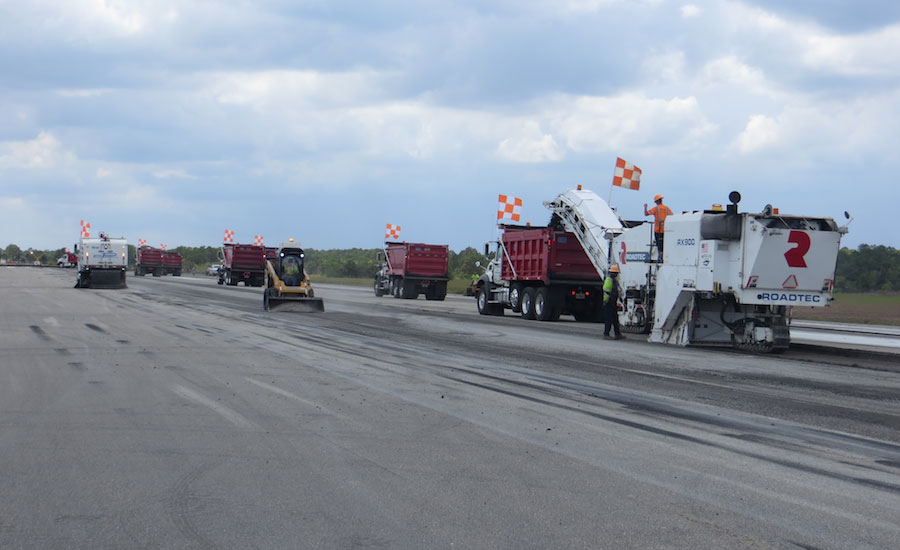A bill to reauthorize the Federal Aviation Administration for five years, including a new airport infrastructure grant program and also an initial $1.7 billion to help southeastern states recover from Hurricane Florence is now on the books. [View text of bill here and bill summary here.]
President Trump signed the measure on Oct. 5, two days after it won final congressional approval when the Senate passed it on an overwhelming 93-6 vote. The House approved it on Sept. 26 by a strong 398-23 vote.
Besides the FAA authorizations and the post-Florence funds, the legislation also has provisions directing the Federal Emergency Management Agency to put more emphasis on pre-disaster planning, by requiring FEMA to devote part of its overall relief funding to early mitigation work.
It also contains the BUILD Act, which will combine several existing U.S. international development programs into a new U.S. International Development and Finance Corp.
Current FAA authorizations were set to lapse on Sept. 30. But Trump signed a one-week extension on Sept. 30, which gave the Senate a bit more time to vote on the five-year FAA measure.
In one of bill's major construction provisions, it holds authorizations for FAA’s core Airport Improvement Program infrastructure grants at their current level of $3.35 billion per year, through 2023.
But it also has a multi-year authorization for a new airport infrastructure program composed of discretionary grants.
The measure authorizes $1.02 billion for that program in fiscal year 2019. Funding then will rise slightly each year after that, to a maximum of $1.11 billion in fiscal 2023. AIP is financed by user fees that flow into the Airport and Airway Trust Fund; the new grants would come from the general fund.
At least 50% of the annual allocations will go to small hub and non-hub airports. Larger airports, including major hubs, are eligible for the other portion of the new program's annual funding.
The new grants are subject to annual appropriations, but congressional appropriators already launched a similar program, totaling $1 billion for such grants in fiscal 2018, with a priority placed on applications from small and rural airfields. Lawmakers drew on a congressional budget agreement that allowed for an additional $10 billion in overall infrastructure spending in 2018 and in 2019.
One difference is that under the 2018 appropriation measure, the new grants carry a 100% federal share; the proposed authorization bill caps the federal share at 80%.
Airport groups were unhappy about the bill. Kevin Burke, Airports Council International-North America CEO, and Todd Hauptli, CEO of the American Association of Airport Officials, said in a joint statement, "The airport industry cannot get behind this proposal, given the flat federal funding level, continued federal interference with local airport financing flexibility and new federal mandates."
The new bill doesn't change the limit on passenger facility charges (PFCs), another key financing resource for airport infrastructure. Airport groups have been pushing for years for Congress to lift the PFC cap, which has been $4.50 per flight segment since 2000.
Brian Deery, senior director of the Associated General Contractors of America's highway and transportation division. notes that although the new FAA bill provides airport grant authorizations, there's no guarantee that appropriated funds will be there past 2019. What's still needed, he says, are both a new budget deal and specific post-2019 annual appropriations for airport grants.
"They pushed one of the buttons that needed to be pushed," Deery says. "But there's still two other buttons that need to be pushed before that money will becoma a reality for the AIP program." The same holds true for the new discretionary airport grants.
Post-Hurricane 'Down Payment'
The FAA package goes beyond aviation to include $1.68 billion for Housing and Urban Development Dept. community development block grants for declared 2018 natural disasters, chiefly the recent Hurricane Florence which hit North and South Carolina particularly hard.
House Appropriations Committee leaders welcomed the disaster-relief aid but indicated that additional money is likely down the road.
Committee Chairman Rodney Frelinghuysen (R-N.J.) said in a Sept. 23 statement, “This legislation will provide a first round of assistance for the residents who must rebuild their homes, businesses and lives in the wake of this disaster.”
The committee's top Democrat, Nita Lowey (N.Y.), said in a statement, “While this down payment is important, it is obvious that more funding will be needed to repair transportation infrastructure and address other needs in the wake of this devastating storm.”
South Carolina Gov. Henry McMaster says that preliminary estimates show his state will need about $1.2 billion for post-Florence aid from Congress. In a Sept. 20 letter to his state's congressional delegation, McMaster said $540 million of that would come from HUD community development grants.
The new legislation also includes a long list of other FAA policy changes including provisions that the lead House negotiator, Transportation and Infrastructure Committee Chairman Bill Shuster (R-Pa.), said would provide “a pathway to ensuring safe and secure drone operations.”
Story updated on 10/6/2018 to include Trump's signing of the bill.




Post a comment to this article
Report Abusive Comment